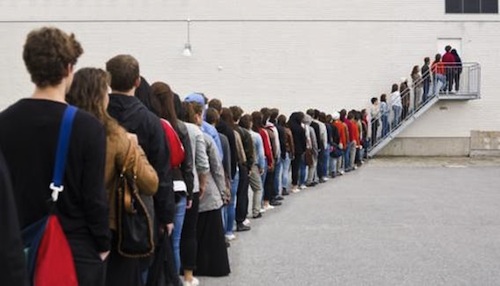Waiting on lines is terrible, but a seemingly unavoidable fact of life, right? Think about this, though: 20 years ago, the Internet was nascent, and finding an effective way to search was hard, but an unavoidable fact of life. (Cue Google.) 15 years ago, you need a few address books, some picture albums, and a good memory (and solid checking account) to know what was up with your friends and their kids and their broader life. It was hard, but I mean, ’twas an unavoidable fact! (Cue Facebook.) Four years ago, if you wanted a cab, you had to call and wait the possible 45 minutes, or go outside where you’re at — regardless of neighborhood — and try to get one. It sucked, but it was just one of those things… (Cue Uber.) There’s a thousand other examples like this.
So what about that idea of waiting in line? Could it be fixed?
It’s a long road, to be sure, but there are companies working on it — like QLess, recently given a short profile in Fast Company. Lest you think a line-elimination service would only benefit us as consumers, stop and reflect on this:
His company’s clients are reaping big rewards from implementing the service, too. “Our customers–retailers, government agencies, healthcare providers, colleges and many other establishments–have consistent five-star reviews, 95% positive customer feedback, increased revenues from reduced walk-outs, 75% reduction in turn-aways, and data and analytics that allows them to manage locations much more effectively,” says Bäcker, who hails from Buenos Aires and runs the company from Pasadena.
In the modern era, where there are 100 options for almost everything you want to do from eating out to gas stations to cleaning services, customer reviews and word-of-mouth context mean a lot. If a place was in bed with QLess and their lines were essentially non-existent, don’t you think more people would head to that place? Indeed. Check it out at the apex of line-waiting: a DMV.
There are competitors in the space, but QLess has a bit of a “first mover advantage,” and their code has been able to evolve over time as a result. One of the big aspects of QLess’ relatively high adoption rate — about 15 million people have used it in some form or fashion — is the fact that it’s a bit more complex than the simple “We’ll buzz you when the table is ready” device you remember from a restaurant:
“There is a big difference between sending a text message when a table is ready,” says Backer, “and building a scalable, automated, interactive, mobile wait management, marketing and CRM solution that works for every phone anywhere in the world via both SMS and voice calls, lets guests enter a virtual queue from their phone, keeps customers engaged during their wait, significantly reduces no-shows, gets 98% opt-in rate and has customers raving about it.”
Another cool thing: their CEO/co-founder put up a whole Wiki of mistakes he’s made along the way. More on that here, too.
The company went from about 2 people initially to over 30 now, so there’s clearly some growth there. They went to a global model recently as well, which will have certain challenges — but also is a good thing in most respects.
Look, can lines completely be eliminated from the Earth? Probably not in the lifetime of anyone reading this, no. But … does there exist, within technology, a way to reduce lines (and eliminate them in some places)? Absolutely. It’s awesome to see someone disrupting (or attempting to disrupt) one of the most fundamental annoyances of human existence.
